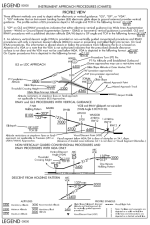Craig,
I understand your frustration, and also feel this is an opportunity to learn (or in my case, reinforce a lesson

). After retiring from the 737 world (Luv'd it

), I've jumped into a G200, and went from flying a lot of ILS and RNAV (RNP) approaches, to a fairly different AP/FD system, and a wider variety of RNAV GPS approaches, both precision and non-precision. The G200 has the same APCH button as you describe, that arms both lateral and vertical flight director and autopilot modes (the 737s I flew did not). Took a little getting used to.
On an ILS or LNAV/VNAV (precision) approach, pushing that button arms both FD modes and if the AP is on, it captures both. If, instead, we're flying a NP approach (LOC only or LNAV only...like the one you are referring to), we capture course guidance with the NAV button, and fly the vertical path with VS. Selecting the APCH button would be a programming error for this type of approach. The recommended rate of decent and GP angle from the chart, in this case, is a reference that can be used in selecting a VS to fly the vertical path smoothly. If we were to try to fly a LOC only or an LNAV (only) NP approach (like your approach) by hitting the APCH button, what happened to you, would happen to us. There is no GP to capture, so it would fly happily along the lateral path and not begin descent. That GP "armed" annunciation would lie to us the whole time, and it would not capture a glide path, because there isn't one to capture. It's there because
we chose the wrong mode on the FD/AP, not because it has an inherent flaw. Our bad, not it's bad. That would have been an approach planning error on our part, that should have been caught in the approach brief (noting and briefing the NP nature of the approach, and briefing the appropriate modes to be used...in this case, NAV and VS).
Another way of saying what you said above is, if there is no vertical guidance, don't select APCH..., i.o.w., don't
try to arm GP (meaning us, the pilots...because it's not going to work). Understanding the approach we are flying, and using the correct modes, is the key to safety in this situation. With two pilots to vet it, it may perhaps be easier to catch and trap those errors. In single pilot IFR ops, its even more important to study the plates, and self-brief all the nuances (and limitations) of a specific approach.
Good reminder for me

Cheers,
Bob


